Bear-hounding is a hunting technique, in which a pack of dogs pursues a bear until exhaustion—at that point the hunter can make his kill. And that is to what Karen Shakhnazarov, a well-known Russian filmmaker of Armenian origin, compared Russia’s predicament in the current geopolitical situation.
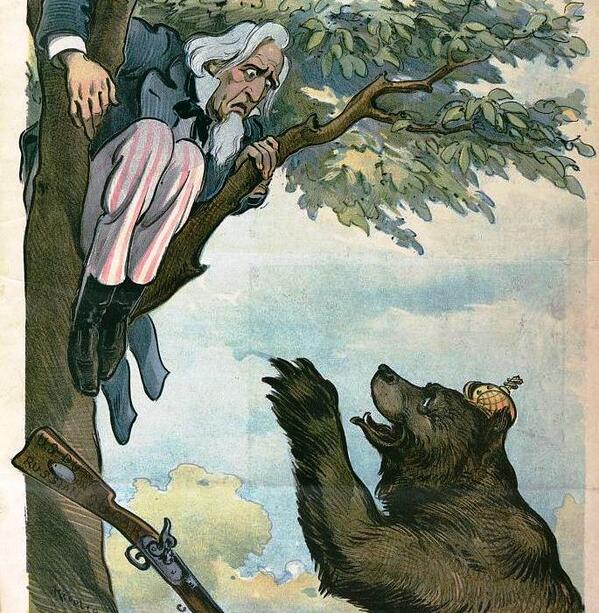
As the Tariff-War Must End, Udo Keppler, Puck, U.S., 1901. Source: LOC.
The bear analogy in Russia’s case is a contrived and, often, derogatory image describing the barbaric Other outside the West. It has deep historic roots, as literary and artistic examples indicate. But it is also one that works metaphorically. As a large continental power spanning Eurasia including some of the coldest places on earth—one with nuclear capabilities—Russia is not unlike the bear. In fact, many Russians themselves have reappropriated this comparison.
Even President Vladimir Putin has used it on a number of occasions.
I gave an example at the so-called Valdai Club remembering our most recognizable symbol, the bear, that guards our taiga. If we follow through with this analogy, then I sometimes wonder whether our bear should, perhaps, sit quietly instead of chasing pigs and piglets throughout the taiga, eating berries and honey. Perhaps, then he would be left alone. [But t]hey won’t leave him alone, because they’re always trying to chain him up. And as soon as they’re able to put him on a chain, they’ll pull out his teeth and declaw him. In today’s context, this is the power of nuclear deterrence. As soon as, God forbid, this happens, and the bear is no longer needed, they’ll appropriate the taiga.
In the past few of years, as Russia made its return to the global arena, the number of such “bear-hounding” episodes has dramatically increased. They have become even more frequent in the past two months alone since a terrorist bomb exploded on Russia’s airbus over the Sinai Peninsula. These episodes range in scope and scale and include fields as diverse as sports and the media, or the downing of the Russian bomber jet by the Turkish government. Some of them were preplanned, others—used opportunistically post-factum for propaganda purposes, but most are part of the general strategic trajectory of containing and weakening what has been dubbed as ‘resurgent‘ Russia.
WHY IS RUSSIA PERCEIVED AS A THREAT?
Why does today’s Russia pose such a threat to the current international status quo? It is certainly no longer Communist—if we are to take the official Western argument about its dangers at face value—and thus does not seek to promote a particular ideology to the rest of the world. Indeed, this country is not yet fully sovereign, primarily because of the Liberal economic direction inherited from the 1990s when the International Monetary Fund (IMF) ‘guided’ it all the way to hyperinflation. Even its Constitution is based on Western models from the same period.
Russia, however, is sovereign enough to challenge Washington’s global hegemony, by advocating various international and domestic aspects of multipolarity, and to dare talk about challenging this hegemony in public. Thus, the Pentagon lists Russia as one of the top threats to the U.S. in its military strategy. (In contrast, the Russian military doctrine mentions general threats, including NATO, but not individual states.) After all, creating a confrontation between Russia and the EU justifies U.S. presence on that continent and NATO’s very existence, which seemed to have been lost after the Cold War. The Russian Federation is also a large, resource-rich land, which is very attractive to foreign capital that has its own interests in mind rather than those of Russia’s citizens. Some of those energy resources are sold to China, the biggest competitor to the U.S.
And what is this current global order? It is one, in which Washington has played the single dominant role since the dissolution of the Soviet Union, acting, in part, through inertia of expansion, using soft and hard power on its unequal allies and vassals—the so-called international community—and less cooperative states. It does this so as to maintain both the prestige of its self-imposed global leadership, at times bordering on messianism, and to make itself, the self-described ‘indispensable nation‘, a safe financial haven—protected by the world’s oceans—amidst growing pockets of chaos and instability. To a significant extent, this instability was created through Washington’s own foreign policy, in order to service its unimaginable $18-trillion debt, not to mention weapons sales during wars and construction contracts after them.
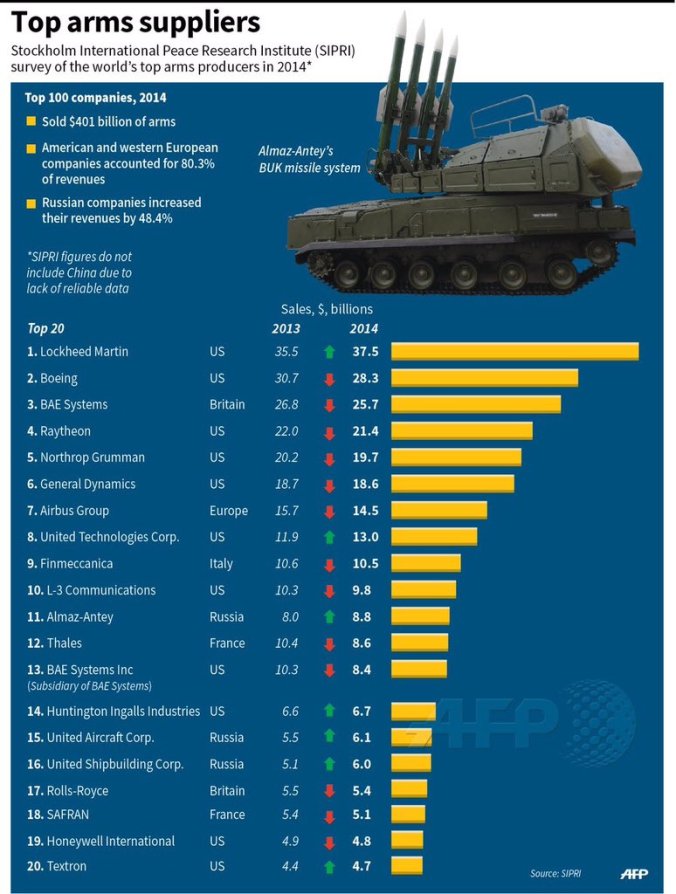
World’s Top Arms Suppliers, 2014. Source: AFP.
HOW CAN RUSSIA BE WEAKENED?
Historically, Russia, a large contiguous country, has been nearly impossible to conquer in a traditional way, if bloody Napoleonic and Hitler invasions are of any indication. Most notably, regime change occurred when internal contradictions and actions of weak, gullible, or treacherous elites had reached a boiling point, whether in the early 1600s with rule, effectively, by the Polish-Lithuanian Commonwealth, the 1917 February and October Revolutions, or the 1991 collapse of the USSR. Since nuclear capability precludes conventional warfare, the tactics used against Russia in the last number of years have been hybrid. The goal of weakening this country relies on generating sufficient unrest amidst society or the elites in order to damage or displace the current sovereign trajectory executed and embodied by Putin and his circle, specifically.
TAKING SMALL BITES
Let us examine some of the notable episodes of hybrid warfare—what we dubbed as “bear-hounding”—applied to Russia.
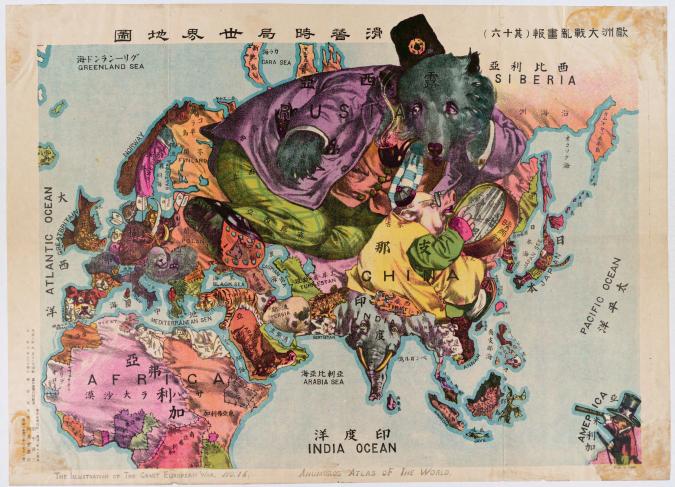
The Illustrations of the Great European War No. 1. A Humorous Atlas of the World. Ryozo Tanaka (attributed). 1914.
Media
This is the most overt factor in anti-Russian methodology. Detailing attacks on that country and its leadership in Western mainstream media could easily turn into a book of its own, though one does not need to go any further than the slanted coverage of the events outlined below. The purpose of this hyperbolic, half-truthful reporting is to influence public opinion in order to support particular government decisions in the West. Indeed, some commentators have described the current situation as being worse than the Cold War era.
In part, this media modus operandi is a result of low-quality, tabloid-like journalism by those, who neither have the academic background, nor the language skills, nor the travel experience covering Russia. In part, this is an aspect of Postmodernity in terms of the general nihilism it exemplifies.

A selection of magazine and newspaper covers from the world’s self-described free media.
Resorting to comic-book Manichaeism, the country’s leader is portrayed as a madman, Darth Vader, mafia boss, or just a mass murderer; whereas its people are said to be a gray mass of servile slaves with no opinions at all (why else would they rally behind Darth Vader?). Herein lies the paradox: the more accessible today’s Russia (as compared to the closed-border Soviet Union), the more simple it is to obtain accurate information about it on the Internet (as opposed to being limited to press and academic narrative before the Internet’s invention), the worse the attacks.
Athletics
In 2015, there have been two major media scandals in the world of sports pertaining to Russia. One was the allegation of corruption in FIFA, the governing body for international soccer (football), and the other—the doping scandal based on the accusations of the World Anti-Doping Agency (WADA). Of course, these scandals came in the wake of another media campaign to tarnish the Sochi Olympics beyond any reasonable form of criticism.
When it comes to the former, the decision by the U.S. Department of Justice to prosecute FIFA is, at best, curious, considering that this country only has a nascent soccer culture. It becomes even more curious thanks to the fact that the Justice Department is investigating the hosting rights to the 2018 World Cup, coincidentally to be held in Russia, so close to the tournament’s date. The investigation goes back almost twenty years, but seems to exclude the 1994 World Cup held in, you guessed it, United States, at a time when this country had even less of an interest in soccer. And, if the investigation had actually gone on for two decades, then this is more than enough time to engineer desirable instances of corruption where there was none before. In addition to tarnishing Russia, the FIFA scandal demonstrated the subservient role of Europe that had delegated its sovereignty to Washington. Even Switzerland, historically known for its neutrality, quickly abided by the U.S. demand to extradite FIFA officials.
The doping scandal is also worth examining. The allegations led to the suspension of Russian athletes by the International Association of Athletics Federations (IAAF). This ban means that Russian competitors will not be able to participate in the upcoming Olympic Games or host international events, like 2016 World Junior Championships domestically. Those following the world of sports would know that doping cases are fairly common, including world-famous athletes like Lance Armstrong or the scandals with the U.S. track-and-field team.
When it comes to the current WADA case on Russia, let us assume that the truth is not somewhere in the middle, as it often is, but that the accusations about doping are 100% accurate. In that case, it is necessary to punish those athletes that had broken the rules. But this is not what is happening. Indeed, the IAAF is employing collective punishment on the entire All-Russia Athletic Federation (ARAF) team, including athletes that are not using such performance enhancements. In addition, the decision to ban—publicized less than a year before the most important international sporting event, the Summer Olympics—raises many questions about the timing.
Ukraine, Donbass, and Crimea
Ukraine has been a pressure point, or a geopolitical pivot, to quote Zbigniew Brzezinski, used against Russia since 1991. Indeed, some analysts would argue that this strategy goes back to relying on Galician Banderites in various capacities after the Second World War. Because working with that country’s corrupt elites had not been difficult, Washington alone officially invested $5 billion into the creation of the so-called civil society, that is, an entire class of opinion-makers and media personalities hostile to the country’s historic roots and heritage shared with Russia. Using Ukraine as project anti-Russia was not only meant to cordon Russia off from the European Union, but also to damage much of the trade and manufacturing sectors that have been historically oriented toward each other since these were republics within the USSR.
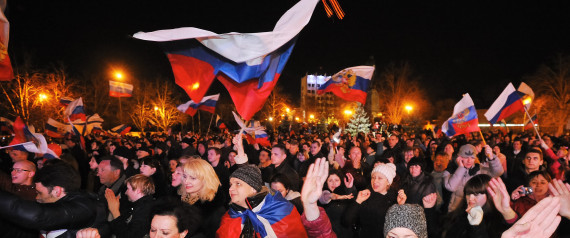
Sevastopol celebrates the results of Crimea’s referendum about joining Russia on March 16, 2014. Petr Kassin/Kommersant, Getty Images.
However, the West-backed regime change was imperfect, since the majority-Russian and autonomous republic of Crimea, strategically positioned on the Black Sea, reunited with Russia through a referendum. At the same time, majority-Russian Donbass held massive protests, which the Kiev government, with the financial and military backing of its Western supporters, has been trying to crush for over a year and a half. The war has not only been used as an informational weapon against Russia. It also led to economic sanctions, described below, and an ongoing financial drain through the influx of over a million refugees, making it a top asylum destination, not to mention the necessary and ongoing deliveries of humanitarian aid.
Yet, the Minsk-2 agreements—guaranteed by Russia, France, and Germany—had minimized the scale of fighting, if not bringing about full peace. This left the Ukrainian government and its Washington backers both with less reasons to justify the ongoing economic collapse domestically, that could no longer be written off by war, and with less options of using project Ukraine against Russia. Thus came the Crimean blockade, damaging Ukrainian businesses more than the peninsula itself, and the terrorist act of blowing up the electric pylons by Ukrainian ‘nationalists’, as the government tacitly stood by—despite Russia’s regular gas deliveries all last winter. This act left 2 million Crimeans, and hundreds of thousands of Ukraine’s own citizens, in the dark for days.
To complicate matters further, the International Monetary Fund (IMF) changed its rules in order to continue lending to Ukraine, as the country was on the verge of default. The Fund’s game changer, in part, excused not paying back Kiev’s debts to Moscow; later, however, the IMF confirmed that the debt was sovereign. This won’t improve the situation for average Ukrainians, but it is largely a tool to pressure Russia. This decision on the part of IMF—to which the U.S. is the biggest contributor at 72%—came virtually at the same time as the U.S. Vice President Joe Biden visited Ukraine for the fourth time since the regime change in 2014 for another round of consultations.
Some Russian commentators have joked that the invisible hand of the market changed the market rules. IMF once again definitely proved that it is not an economic, but a political instrument. It also delegitimized itself by showing that it has one set of rules for Greece and Portugal, and another—for Ukraine. Of course, while Kiev’s currently discussed debt to Moscow is $3 billion, since 1991, Russia had given that country financial aid in various forms totalling somewhere between $200 and $300 billion. The European Union, in turn, had provided around $19 billion. Much of that money ended up in the pockets of the oligarchs, Bloomberg admitted.
Economic Sanctions, Ruble, and Energy
Crimean reunification with Russia and war in Ukraine—both the result of the West’s own actions—have been used as a pretext to punish Russia through sanctions, or, rather, unilateral economic measures. The term “sanctions,” is, of course, a misnomer, since only the United Nations Security Council can issue them. The purpose of these economic measures was to lower the standard of living for average citizens, scare the elites, thereby creating social unrest and, in time, change the country’s leadership to someone more pliable.
These measures were issued by the United States and the European Union, along with a number of other countries like Canada, targeting economic, defense, and energy sections, as well as individuals. Certain Russian companies are no longer able to rely on Western credit—a measure designed specifically in light of this country’s aforementioned dependence on the Liberal economic model. Indeed, Joe Biden admitted to having pressured Europe into implementing them. And, the EU was reluctant to engage, considering that, as expected, these measures later caused substantial economic damage to individual countries in the Union. Next, sanctions have been renewed under false pretext of fulfilling Minsk-2 agreements on Ukraine, to which Russia is not a party, but a guarantor. Indeed, they may stay in place for decades: those issuing them only choose to remove them when they see no desired effect and, indeed, prolonged damage to themselves, as was the case with China.
In addition, the ruble fell substantially, in part, as a result of the dropping oil price. We should note that the U.S. economy is also hurt by this. Some have suggested that what is now a competition between Russia and Saudi Arabia is based on oil-price manipulation by the latter. One of the major factors at play here is that these two countries are at war for the Chinese market.
However, Russia is not a ‘gas station‘ of a nation that certain commentators would like to think. Its oil and gas exports have not exceeded 16% of the GDP. Of course, the situation is more complex, as this number does not include related industries. Nonetheless, it is the oil price, not sanctions that have negatively affected Russia’s economy, some Western experts say.
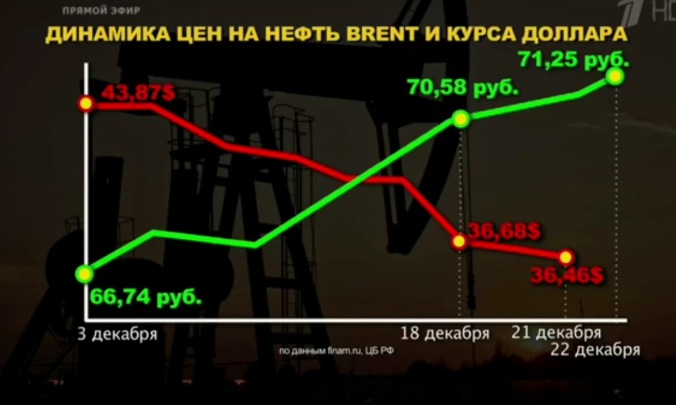
The direct correlation between the Brent Oil Price (red) vs. Ruble (green), Dec. 3-22, 2015. Source: finam.ru, Russian Central Bank.
They also admit that Russia is in better shape economically than Barack Obama’s statement about leaving it “in tatters.” Indeed, inflation may translate into greater exports for Russia, and economic restructuring of the domestic market in order to replace banned goods may benefit the country’s own producers. If Putin’s estimates are to be believed, the situation is nowhere near ideal, but the worst of the crisis is over. Most important, the greatest reason for the so-called sanctions—to cause domestic discord—seems to have failed, as the president’s ratings remain high thanks to rallying the nation behind him.
The creation of an artificial rift between Russia and the European Union—constantly maintained through media tools—is beneficial to Washington. Russia and the EU are trading partners in various fields beyond energy resources. But energy is of great significance: the U.S. plans delivery of liquefied gas to Europe in 2016, and is pushing Russia out of the market that it dominates. Indeed, certain countries in the EU are undermining the Nord Stream-2 project, effectively trying to force Russia into continued dependence on Ukraine for transit purposes.
It is also not coincidental that U.S. think tanks like Stratfor list disrupting the union between Germany and Russia as one of Washington’s key strategic goals: German industry and technology and Russia’s resources, as in classic geopolitics, would create a powerhouse of an alliance and challenge Washington’s hegemony. Neither is it coincidental that the Transatlantic Trade and Investment Partnership (TTIP)—the negotiations for which had been shrouded by mystery as far as the public is concerned—is a protectionist measure by the United States also created to eliminate competition, such as China and Russia. The same applies to the Trans-Pacific Partnership (TPP), the protectionist trading bloc in Asia. So much for the proponents of the free market.
Turkey, Middle East, and Terrorism
The complex situation in the Middle East is akin to a multi-layered cake, in which geopolitical rivalries are entangled with regional interests and religious disagreements. There are several centers of power, including the U.S., Israel, Turkey, Saudi Arabia, Qatar, and Iran. As of recent, this list extended to Russia with its legal engagement in combatting terrorism in Syria—including hundreds of its own citizens, who joined Daesh (‘Islamic State’) and could come home— and defending its own regional interests in the Caspian. We must not underestimate the extent to which certain Middle Eastern countries are capable of acting as autonomous players, despite their alliances with Washington in various formats, as the case of Turkey’s entry into Iraq—that does not necessarily work for the U.S.—indicates.
Considering that it is Turkey, with which Russia is experiencing an open confrontation following the downing of its SU-24 bomber, let us focus on on it. The neo-Ottoman aspirations of Recep Erdogan’s government are limited by political realities of the region, where Turkey does have the ability to exert substantial influence, military and otherwise, on Iraq and Syria in light of their respective weakened, war-torn status.
Turkey’s relationship with Russia has been amicable only in the last decade, primarily for economic reasons, following a history of numerous wars, most of which Turkey, or the Ottoman Empire, lost. Russia’s involvement in the Syrian conflict upon that government’s invitation undermined both the Turkish expansionist aspirations and the terrorist oil trade across the Syrian border, particularly when Putin publicized some of the data implicating G20 member states in none other than Antalya. Mere days after this revelation came the downing of Russia’s SU-24 bomber over Syria. Of course, there is also precedent of Turkey allowing known terrorists from Russia’s North Caucasus to receive medical treatment and training.
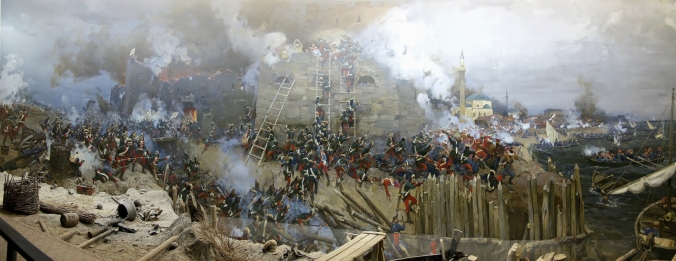
Storming of Ottoman Izmail (outside today’s Odessa) in 1790. Diorama by Danilevskii and Sibirskii, 1973. Eventually, Russia gained Crimea.
Nor is Turkey the only state in the region with links to terrorism. Analysts have alleged that both the incredibly wealthy Qatar and Saudi Arabia are state sponsors of terrorism and exporters of Wahhabism—of particular relevance to the Syrian conflict and beyond. This makes their participation in the illegal U.S.-led coalition against Daesh and their massive entanglements in Europe rather eyebrow-raising, much like Saudi-Arabia’s own recently launched Islamic anti-terrorist group.
What today’s official Turkey has in common with post-regime-change Ukraine is its superior geostratetic position that, as of recent, both countries have been selling to the highest bidder as an anti-Russian platform. We, the general public, will likely never learn—perhaps, from an official’s memoirs years from now—the exact details of Turkey’s provocation with Russia’s bomber and the subsequent murder of one of its pilots in Syria by the son of a Turkish ex-mayor and Grey Wolves member. Cui bono is a more difficult question than it may appear.
On the one hand, a major disagreement between Turkey and Russia benefits Washington by having their respective attention directed and energy wasted toward a growing disagreement with each other, such as the embargo implemented by Russia or its cancellation of visa-free travel. One of the most significant components here is the Turkish Stream project—after tiny Bulgaria was brought to heel with the abandonment of planned South Stream—threatening the Washington-led order by maintaining Russia’s energy supplies into continental Europe. Undermining Turkish Stream helps other energy-supply routes, like the Trans-Anatolian, Trans-Adriatic and other pipelines connecting Middle East—Saudia Arabia and Qatar—to Europe through Azerbaijan and Turkey, thus checking both Russia and Iran. It is no coincidence that shortly following Turkish PM Ahmet Davutoglu’s visit to Baku—who said that Azerbaijan could participate in joint energy projects if Armenia withdraws from ‘occupied’ lands—Azerbaijan shelled Nagorno-Karabakh for the first time since the 1994 ceasefire.
And Washington has many ways of pressuring Turkey. Suggestions of domestic instability by using the Kurd factor would certainly be taken seriously from those who have orchestrated many color revolutions. Most important, it is doubtful that Turkey, a NATO member, would have carried out such a brazen act—the first downing of a Russian (Soviet) military plane in 60 years—without having any communication with the organization.
On the other hand, Turkey is a major regional power with its current leadership sharing neo-Ottoman aspirations, as mentioned above. Its strategically excellent position, over the old Byzantine Empire, between Europe and the Middle East, controlling the straits and, more recently, the refugee influx into Europe, give it major bargaining power—3 billion euros from the EU, to be exact. During the Cold War, this country used its geostratetic position for housing Jupiters, American nuclear weapons, against the Soviet Union. The aforementioned energy-transit projects, including checking Russia and Iran, are, of course, beneficial to Turkey itself.
Currently, its NATO membership makes the Erdogan government feel protected to act as it wishes. Indeed, NATO’s initial reaction to the downing of SU-24 was ambiguous. Yet, that things did not work out quite as hoped is obvious from the incident, in which a Russian destroyer fired warning shots at an approaching Turkish fishing vessel in Greek waters, after communication attempts failed, no doubt reminded of USS Cole bombing. This failed provocation—following the revelation about its terrorist-oil links in Syria and the plane downing—is a sign that Turkey is trying to change its perception in the West to that of a victim.
NATO Expansion
And what about NATO? We know that this military alliance has been moving ever closer to Russia’s borders since 1991 despite guarantees made to Mikhail Gorbachev. Many commentators, like Richard Sakwa, have pointed out that whereas the Warsaw Pact is long-gone, NATO keeps expanding: it “exists to manage the risks created by its existence.” Indeed, in an Orwellian twist, this multi-national, Washington-dominated organization, designed to “to keep the Russians out, the Americans in, and the Germans down” even refers to itself as an omnipresent super-entity by using terms like “NATO’s borders.” The alliance brazenly holds military parades in the Baltic 300 meters from Russia’s border, all the while accusing the latter of aggression.
Whereas NATO supporters like to emphasize that its membership is voluntary, one need not go further than places like the artificially created ‘state’ and organ-trafficking center Kosovo, where the alliance has had an indefinite presence without membership. Most recently, the alliance formally invited Montenegro—another place forged out of Yugoslav wars and dismemberment, including NATO’s bombing in 1999—to join its ranks. And remember those alternate pipeline routes through Turkey into Europe? If Serbia refuses to participate due to its links to Russia, Montenegro could potentially step in. In contrast, Russian leadership has advocated for Balkan neutrality, interpreting this particular event as one of pure geopolitics with no security gains.
And they are right. The argument that NATO’s recent expansion is a response to ‘Russian aggression in Ukraine’ is meaningless, when the Baltic states or countries like Romania and Bulgaria ascended in 2002-2004. Neither does ‘Russian aggression’ explain the unilateral withdrawal from nuclear-arms agreements like the ABM treaty, which the U.S. left in 2002. Another curiosity is keeping U.S.-placed nuclear weapons in Europe—that were said to protect the continent from Iran—after signing a nuclear deal with that country. And all that military equipment the U.S. brought to Europe for training, commitment to NATO allies, and a “highly visible demonstration of U.S.” itself on European soil? It stayed on the continent even after the training was over.
WHAT CAN RUSSIA DO?
There is no secret recipe for instant success—only hard, consistent work in every applicable sphere from the military to the media. In short, Russia should do what it has been doing thus far, while learning from its mistakes.
One of its biggest, it seems, is a reactive rather than a proactive manner in handling certain crises. In the Ukrainian scenario, for instance, there have been signs of an upcoming disaster since 1991, whether historic rewriting or the crackdown on the Russian language. But unlike Washington’s investment in opinion-making, Russia’s leadership only worked with the elites by primarily by subsidizing the energy sector. Instead, it should have built upon the lengthy historic and cultural links between Ukraine and Russia by going to the people through cultural institutions. Of course, Russia was weak for much of the period in question, and we know what they say about hindsight.
There have been notable successes. One was the presentation by Almaz Antey on its investigation into the MH17 crash that preceded its veiled counterpart by the Dutch Safety Board on the same day, taking the wind out of the latter. This disaster has been used in a concerted media campaign to damage Russia—mere hours after the initial crash—economically and politically, even though there is substantial evidence implicating the Ukrainian government, on whose watch this occurred. Thus, being first to occupy the international information space and set the agenda based on transparent, empirical, and easily verifiable findings was the correct thing to do.
In the most dangerous arena, Russia must not fall for provocations, which may escalate around its perimeter, including Central Asia, and within, the North Caucasus.
It must pursue all international platforms to disseminate its point of view, even those skewed against it. When it comes to Washington and its allies, only a consistent display of power like the early successes in the Syria campaign, led to joint diplomatic measures, such as the U.S.-backed UNSC resolution.
In terms of the economy, Russia must continue gradual de-dollarization through a variety of means, such as converting to direct trade in each other’s respective currencies with its partners. It must also change the Liberal direction inherited from the Alexei Kudrin government, for instance, by reducing the holdings of U.S. treasury securities.
Correctly implementing already defined measures to grow and diversify the domestic market in light of Western sanctions is another challenge. Internationally, Russia must participate in institutions that serve as alternatives to the current order, such as the Asian Infrastructure Investment Bank. Indeed, Russia, within the framework of BRICS, must turn the New Development Bank into a real alternative to structures like the IMF beyond media campaigns.
One of the most important aspects of Russia’s strategy in just about every arena is diplomacy and soft power as part of a cohesive “Russia brand.” In particular, this country must focus on increased cultural exchanges in traditionally strong fields, literature and the arts. These forms must not be limited to the classics—Tolstoy, Dostoyevsky, Tchaikovsky, and Rakhmaninov—but also embrace modern exemplars, like children’s animation Masha and the Bear, incredibly popular in 100 countries and released in 25 languages.

Masha and the Bear. Source: mashabear.com
Its media presence will be the case of David vs. Goliath of the mainstream Western counterpart in the foreseeable future. Although the increased attacks on Russia’s foreign-language outlets, RT and Sputnik, indicate that the chosen trajectory is correct, and that it should continue setting the information agenda wherever possible.
What Russia needs to do next in the media landscape is quite simple: offer domestic content, such as the excellent weekly geopolitical documentaries on Rossiia channel, to international audiences through the use of subtitles in a timely manner. This will allow it to disseminate its point of view widely and to allow politically savvy audiences abroad to evaluate this content on their own based on the factual data presented in the films.
Most important is leading by example. Unlike the old Soviet Union and today’s U.S., Russia does not promote a single global ideology, seeking adherence from the rest of the world. What it does advocate is national sovereignty in the context of multipolarity along with abiding by mutually established rules, i.e., international law through discussion platforms like the United Nations. The country’s leadership also underscores refraining from exporting one’s own ideas of good and evil onto those, whose culture and traditions differ. Domestically, too, Russia must lead by example by making itself an attractive country—this includes countering disinformation campaigns. For some, Russia can become an exemplar of a place with socially conservative values within the framework of a secular state that respects indigenous religions from Orthodoxy and beyond—an alternative to hedonism and moral relativism of the official West.
And while its increased links with China are a mutually beneficial arrangement, it must find common ground with continental Europe once again, for the latter is its natural partner with shared economic and historic links, despite Washington’s relentless efforts to sow discord. One of the areas, where this connection can be amplified further is a joint fight against global terrorism, particularly in light of the Paris attacks, Brussels lockdown, and others. This kind of cooperation can improve the relationship and lead to joint projects in other areas.
Folk wisdom has staying power because of its simplicity and striking accuracy. Many Russian proverbs underscore the necessity of slow and consistent work to achieve results: “Fairy tales are told fast, but deeds are done slowly,” or “You cannot catch a fish out of a pond without putting in any effort.” And just like those folk tales, the Russian Bear must defend his taiga in a persistent, dedicated way. Only then will the taiga’s residents continue to enjoy its fruits that are rightfully theirs.
A very Informative article.
Russia IS winning the info war. Most European (and American) citizens support Putin, we see him as a strong and patriotic leader. Quite amazing actually, as we are bombarded with anti Russia propaganda 24/7!
An excellent analysis, thank you. Especially the second part, the good advice, is very helpful. Indeed, the Russian Government should be reading your blog regularly.
Great comprehensive article Nina!
You cover many bases.
I think the Western public are gradually getting worn out with 2nd rate MSM propaganda!
A well done analysis. Pity so few are informed or curious enough to become informed about what’s going on. A Sisyphean struggle. If TPP is ratified by Canada, voting will become an impotent farce, as it will in TTIP and TISA trade deal nations should these deals become law.
Pingback: Hounding the Bear: Hybrid Methodology of Containing Russia | examplewo329
Excellent analysis. The best possible and most natural solution of present big world dangers is the abandonment of the dollar. It will be painful but to keep sustaining it will bring world wide economic and political catastrophe
Hope the author truly believes what she writes and decides to relocate to the Russian bastion of freedom and democracy. If not, strongly suggest that she cease writing these geo-political, propagandistic blatherings and stick with photography.
Oh my, and there I thought all along that the West was all about freedom, democracy, and pluralistic thought that allowed for a difference in opinion! I must’ve struck a chord considering these continued ad-hominem attacks on my personal blog (where I can post whatever I want). So there is only one solution: I must write more often. Enjoy!
Pingback: Do You Realize What You Have Done: Brussels Bombings in Context | Nina Kouprianova
Pingback: Today,s Thought
Thank you, for this comprehensive analysis of what is going on with Russia. I agree, Russia needs to expand its cultural contribution to include modern literature and arts. I’d love to read about modern culture in Russia, through great literature. I think it will go a long way in humanizing them, to others, as well. At least, I hope.
Most Americans, if they don’t watch other news sources like RT, only know what is being told to them. Many didn’t watch the whole Ukraine situation unfold, except what was reported on the nightly new during Maidan. Others of us kept watching after Maidan and know about the role the US has played there. The rhetoric has been so ridiculous and over the top that, it should make more of us suspicious as to the motivations behind it.
It’s good to hear from someone who doesn’t just appear to have a beef with their country and therefore, will repeat that with which they are instructed.